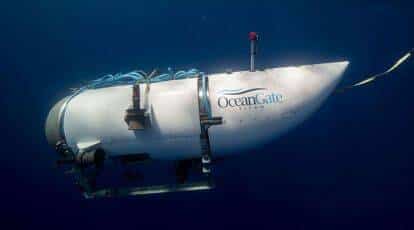What’s in today’s article?
- Why in News?
- What are Submersibles?
- The Titan
- How are Submersibles different from Submarines?
Why in News?
- The Titan, the vessel that went missing in the area of the Titanic wreck in the North Atlantic, is classified as a submersible, not a submarine.
- Numerous complications – weather conditions, the lack of light at night, the state of the sea and water temperature, depth (14000 feet) – could hinder the effort to rescue the five people aboard the deep-diving submersible.
What are Submersibles?
- Submersibles are small, limited range watercrafts designed for a set mission, that are built with characteristics that allow them to operate in a specific environment
- These vessels are typically able to be fully submerged into water and cruise using their own power supply and air renewal system.
- While some submersibles are remotely-operated and essentially manually controlled or programmed robots, these usually operate unmanned.
- Vessels like the missing Titan are known as human-occupied vehicles.
The Titan:
- It was designed to transport five people to depths of around 4,000m in order to reach the Titanic shipwreck, which lies approximately 370 miles south of Newfoundland, Canada.
- Made of titanium and carbon fiber, it weighs around 10,432 kgs and can also take on speeds of about 3 knots/5.5 km per hour.
- It doesn’t have a lot of propulsion so it can’t sail great distances but it has just enough propulsion to sail and operate in and around the wreck and then come back to the surface.
- Experts believe that the Titan likely lost power or communication with its mother ship, the Polar Prince.
- In this case, the Titan’s safety mechanism would activate, causing the ship to release the weight that it had been using to descend to the shipwreck.
●
How are Submersibles different from Submarines?
- The primary difference between a submersible and a submarine is that the former is launched from a mother vessel, or home vessel.
- Submersibles are typically launched on a raft or platform which is placed into water and ultimately descends down via four electric thrusters which help it to reach speeds of 3 knots.
- When it returns to the surface, it must be loaded back onto the surface platform.
- Submersibles don’t have things like typically large propulsion systems, they don’t have ballast systems. They also have limited power reserves.
- Unlike submarines, submersibles also have a viewport and external cameras to view the outside space surrounding the vessel.
Q1) How does a submarine work?
Submarines propel themselves forward through the water using propellers or jets that shoot out water. These can be powered by diesel engines, or even nuclear reactors. They use a rudder, just like a ship, to turn.
Q2) Which will be the second nuclear submarine of India?
Arighat, India’s indigenously-built second ballistic missile submarine (nuclear-powered submarines armed with nuclear-tipped ballistic missiles or SSBN), could enter service by 2024. This will be 2nd after INS Arihant.
Source: Titanic tourist submersible missing: Difference between a submersible and a submarine | IE
Last updated on June, 2025
→ UPSC Notification 2025 was released on 22nd January 2025.
→ UPSC Prelims Result 2025 is out now for the CSE held on 25 May 2025.
→ UPSC Prelims Question Paper 2025 and Unofficial Prelims Answer Key 2025 are available now.
→ UPSC Calendar 2026 is released on 15th May, 2025.
→ The UPSC Vacancy 2025 were released 1129, out of which 979 were for UPSC CSE and remaining 150 are for UPSC IFoS.
→ UPSC Mains 2025 will be conducted on 22nd August 2025.
→ UPSC Prelims 2026 will be conducted on 24th May, 2026 & UPSC Mains 2026 will be conducted on 21st August 2026.
→ The UPSC Selection Process is of 3 stages-Prelims, Mains and Interview.
→ UPSC Result 2024 is released with latest UPSC Marksheet 2024. Check Now!
→ UPSC Toppers List 2024 is released now. Shakti Dubey is UPSC AIR 1 2024 Topper.
→ Also check Best IAS Coaching in Delhi






















